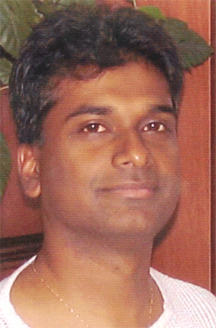The telephone number belonging to murdered HIV counsellor Seeraj Persaud is still active 19 months after his death and his family is wondering what is barring the police from finding the killer.
The man’s phone was said to be a major clue in the investigation as it was among the items that were missing when his lifeless body was discovered in his office at the Parika Health Centre on February 15 last year. Based on information reaching this newspaper, police investigators have failed to actively pursue this aspect of the case.
Speaking to Stabroek News last week, Persaud’s brother, Boyo, said that recently his friend’s wife recounted to him that she accidentally dialled Persaud’s number and a woman answered. “The person kept calling back and asking how she get that number,” he said, while adding that his friend became afraid, especially since an honest mistake had been made in dialling Persaud’s number.

Though he sees this as a big break in the case, Boyo is doubtful that the police would pursue the lead. Nevertheless, his friend is currently in the interior and as soon as he returns he wants to approach the police with this new bit of information.
Police Commissioner Henry Greene had told relatives that investigators were tracking numbers, while explaining that just hours after the murder the perpetrator(s) made calls from the stolen instrument before transferring the remaining credit to another cell phone.
However, that bit of good news turned to disappointment when relatives were told that investigators were calling the numbers but were not getting through to anyone. That explanation was dismissed as unacceptable and unjust, as relatives had opined that it would have been easy for the police to get the addresses of the persons who owned the numbers that they had tracked.
Their contention is that police could have easily gone to the telephone companies and gotten the addresses, since at the time of the murder persons were required to provide proof of address when purchasing a new SIM card or had to take in that information if they already had a SIM card. If this was done, identifying a suspect would have been an easy task.
‘Things dead’
The still grieving Boyo told Stabroek News that “to me it [the case] dead. He dead, so things dead.”
He said he has lost touch with the lead investigator in the case, who he was told was transferred to another location. He said he wanted to go to the police but he does not know who to go to. “Everybody want to know why they kill he in such a manner. He was a good person,” he stressed.
Boyo said he still thinks about Persaud and when he passes the health centre daily on his way to his stall in the market, memories flood his mind. Boyo said that he sometimes visualized how Persaud would have fought for his life as he was being strangled. He said that on birthdays too relatives remember him, because “he knew everyone’s birthday. That is the type of person he was.”
The last word he got, he said, was that a young woman, who Persaud was training at the time of his death, is now the new counsellor at the facility and the staff there are still afraid.
The police came in for heavy criticism from Boyo. In a sombre tone, he said that the police are not interested in solving this crime. He noted that his brother gave up his life in Russia to return home and contribute to Guyana. In the process, he noted, his life was snuffed out and until this day he cannot understand why.
He said that police are interested in everything else besides peoples’ lives and feelings. “They ought to be interested in peoples’ lives,” he stressed.
Linda Johnson, the facility’s health visitor, had recalled to Stabroek News that some time after lunch, she saw someone enter Persaud’s office but did not pay much attention to who it was. She said that two women, who had scheduled counselling sessions with Persaud, were sitting outside the office for some time and one of them eventually decided to knock on the closed door.
Johnson had explained that because of the confidentiality involved, Persaud’s door would always be closed during sessions. After knocking several times and getting no response, the woman decided to open the door and saw Persaud on the floor.
According to Johnson, the woman informed a volunteer, who on checking found Persaud in a crouched position on the floor and ran from the room screaming. This was around 1.50 pm.
There was a fine line around his neck and his laptop computer, an expensive phone, his wallet and a bunch of keys were missing. Manual strangulation was later given as the cause of death. Persaud also sustained blunt trauma during the incident.
Police later identified the suspect as a tall, well-built man, who is fair in complexion. The suspect was seen at a Valentine’s Day voluntary testing activity held in front of the Health Centre. He was then seen the following day walking behind Persaud. There are suggestions that the man had an appointment with Persaud and it was during this time that the murder was committed.
Because of the codified system used when dealing with HIV cases, it would be difficult to say by name who Persaud saw on the day he was killed. No names of patients are written in the appointment book, only a code.
This may be an obstacle for investigators but Persaud’s family members say his telephone number is a lead that ought to be pursued.





